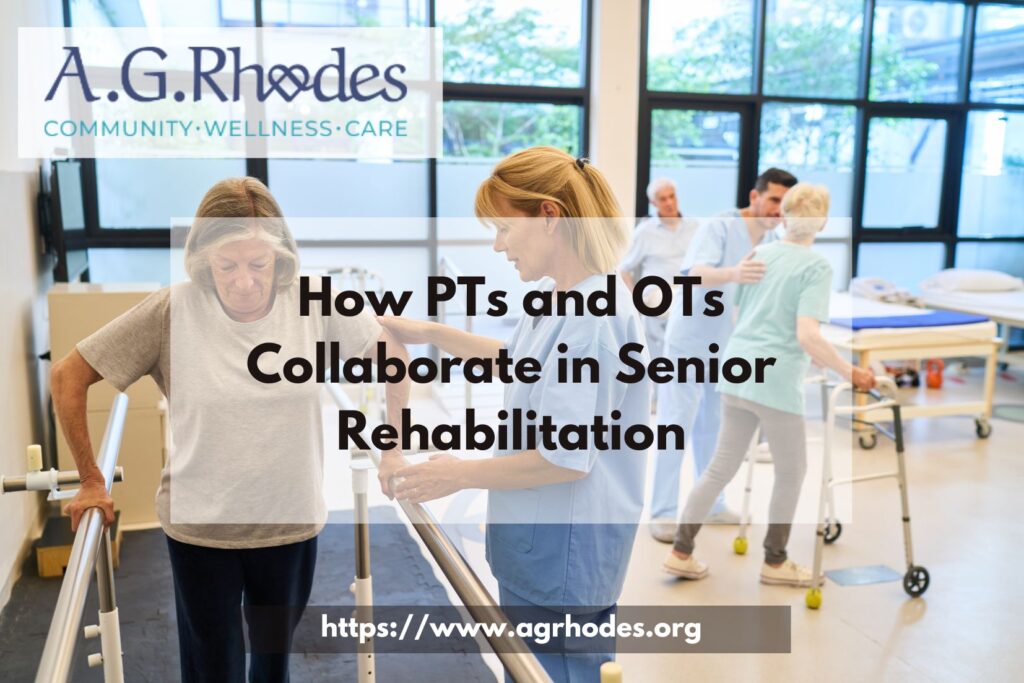Understanding the Distinct Roles of PTs and OTs
 In the world of senior rehabilitation, Physical Therapists (PTs) and Occupational Therapists (OTs) play complementary roles that are both essential to a senior’s recovery and long-term well-being. While their focus areas may differ, their collaborative approach ensures holistic care, addressing both the physical and functional aspects of recovery.
In the world of senior rehabilitation, Physical Therapists (PTs) and Occupational Therapists (OTs) play complementary roles that are both essential to a senior’s recovery and long-term well-being. While their focus areas may differ, their collaborative approach ensures holistic care, addressing both the physical and functional aspects of recovery.
Physical Therapists focus on restoring mobility, strength, balance, and range of motion. They help seniors regain the ability to walk, transfer, climb stairs, and reduce pain.
Occupational Therapists, on the other hand, center their care on activities of daily living (ADLs) such as dressing, bathing, grooming, and cooking. They also help modify environments and tools to make everyday tasks easier and safer.
Together, they create a powerful alliance that maximizes outcomes for seniors navigating rehabilitation.
Why Collaboration Between PTs and OTs Matters
The collaboration between PTs and OTs is not just beneficial—it’s vital for seniors recovering from stroke, surgery, injury, or illness. Seniors often face challenges that involve both mobility impairments and functional limitations. When PTs and OTs work together, their combined treatment plans are synchronized, eliminating gaps and duplications.
This integrated strategy ensures:
- Faster recovery times
- Improved quality of life
- Fewer hospital readmissions
- Enhanced confidence and independence
For example, after a hip replacement, a PT helps a senior build leg strength and balance, while an OT assists in relearning how to safely bathe or dress without reinjury.
Shared Goals, Distinct Approaches
Despite different areas of expertise, PTs and OTs work toward a shared goal—empowering seniors to live independently and safely.
Physical Therapists: Movement Experts
PTs focus on:
- Improving gait and ambulation
- Reducing fall risk
- Strengthening weakened muscles
- Alleviating joint stiffness and pain
- Teaching use of walkers, canes, or braces
They use treatments such as therapeutic exercise, manual therapy, electrical stimulation, and balance training to restore physical integrity.
Occupational Therapists: Function-Focused Care
OTs concentrate on:
- Assisting with ADLs
- Promoting cognitive functioning
- Recommending adaptive equipment
- Modifying home environments for safety
- Addressing fine motor coordination and vision
Their interventions may include task-specific training, energy conservation strategies, and home safety assessments that tailor rehabilitation to a senior’s real-life needs.
Creating Personalized, Collaborative Treatment Plans
At leading senior care communities like A.G. Rhodes, PTs and OTs co-develop treatment plans that evolve with each resident’s progress. This interdisciplinary coordination includes:
- Joint assessments at admission
- Regular care team meetings
- Shared patient notes and documentation
- Collaborative goal setting with families
- Real-time adjustments in response to outcomes
For instance, a PT may identify a weakness in leg muscles during walking, while the OT addresses difficulty standing at the sink. Together, they design a plan where strength-building exercises go hand-in-hand with functional standing tasks.
The Impact of Dual Therapy on Common Senior Conditions
1. Stroke Rehabilitation
- PT Role: Gait retraining, balance work, muscle stimulation
- OT Role: Regaining hand use, cognitive exercises, ADL retraining
2. Post-Surgical Recovery
- PT Role: Restoring strength post-joint replacement
- OT Role: Assisting with bathing, dressing, toileting safely
3. Parkinson’s Disease
- PT Role: Fall prevention, posture correction, mobility drills
- OT Role: Hand dexterity, meal prep strategies, adaptive equipment
4. Dementia Care
- PT Role: Maintaining physical fitness and walking ability
- OT Role: Cognitive stimulation, routine-building, visual cues
Improving Mental and Emotional Health Through Collaboration
Recovery is not just physical—it’s emotional. A collaborative PT/OT team also helps combat:
- Depression due to reduced independence
- Anxiety after traumatic medical events
- Isolation from mobility limitations
By reinforcing both body and function, therapy gives seniors a sense of accomplishment, autonomy, and hope. OTs may introduce hobbies or crafts to lift spirits, while PTs restore the ability to walk to a social event. This teamwork restores dignity, not just function.
The Future of Senior Rehabilitation Is Collaborative
As the aging population grows, demand for interdisciplinary rehabilitation will rise. At forward-thinking facilities like A.G. Rhodes, the partnership between PTs and OTs is central to their model of care. These professionals don’t just treat symptoms—they build lives, one personalized plan at a time.
Partner with A.G. Rhodes for Integrated Senior Therapy
At A.G. Rhodes, we believe every senior deserves comprehensive, compassionate care tailored to their individual goals. Our collaborative teams of Physical and Occupational Therapists work side-by-side to help each resident reclaim independence, mobility, and confidence. Whether recovering from illness, injury, or surgery, our therapy programs are designed to heal holistically and empower for the future.
Contact us today to learn how our customized rehabilitation services can support you or your loved one’s journey to wellness.

